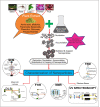An overview of the phytosynthesis of various metal nanoparticles
- PMID: 34790502
- PMCID: PMC8556431
- DOI: 10.1007/s13205-021-03014-0
An overview of the phytosynthesis of various metal nanoparticles
Abstract
Nanotechnology is an emerging branch of science wherein various valuable molecules with altered properties can be synthesized and utilized for numerous technological applications. Nowadays, nanotechnology is the preferred tool for the agriculture, food, and medicine industries. However, consistent accumulation of toxic by-products during the synthesis of nanoparticles from the established physical and chemical methods imposes an unprecedented danger to the environment and human well-being. The biological route for the synthesis of nanoparticles offers a potential option over the conventional chemical synthesis process due to the involvement of non-toxic and environmentally friendly materials, such as plants, fungi, bacteria, etc. Phytosynthesis, a type of biological synthesis, utilizes various combinations of secondary metabolites from different plant parts (whole plant, leaves, fruit peel, root, bark, seeds, and stem) for non-toxic and environmentally friendly nanoparticles fabrication. Non-toxic and environmentally friendly secondary metabolites derived from plants are the sources of reducing and capping agents during the biosynthesis of nanoparticles which proceeds in a controlled manner with desired characteristics. Phytosynthesis of nanoparticles is also a simple, economic, durable, and reproducible process. The present article is a comprehensive depiction of the synthesis of different metal nanoparticles from diverse plant species.
Keywords: Copper nanoparticles; Gold nanoparticles; Magnesium nanoparticles; Phytosynthesis; Silver nanoparticles; Titanium nanoparticles; Zinc nanoparticles.
© King Abdulaziz City for Science and Technology 2021.
Conflict of interest statement
Conflict of interestThe authors declared no conflict of interest with respect to the authorship, and publication of this review article.
Figures
References
-
- Abdelhamid AA, Al-Ghobashy MA, Fawzy M, et al. Phytosynthesis of Au, Ag, and Au-Ag bimetallicnanoparticles using aqueous extract of sago pondweed (Potamogeton pectinatus L.) ACS Sustain Chem Eng. 2013;1:1520–1529. doi: 10.1021/sc4000972. - DOI
-
- Ahmed S, Saifullah AM, et al. Green synthesis of silver nanoparticles using Azadirachta indica aqueous leaf extract. J Radiat Res Appl Sci. 2016;9:1–7. doi: 10.1016/j.jrras.2015.06.006. - DOI
Publication types
LinkOut - more resources
Full Text Sources


